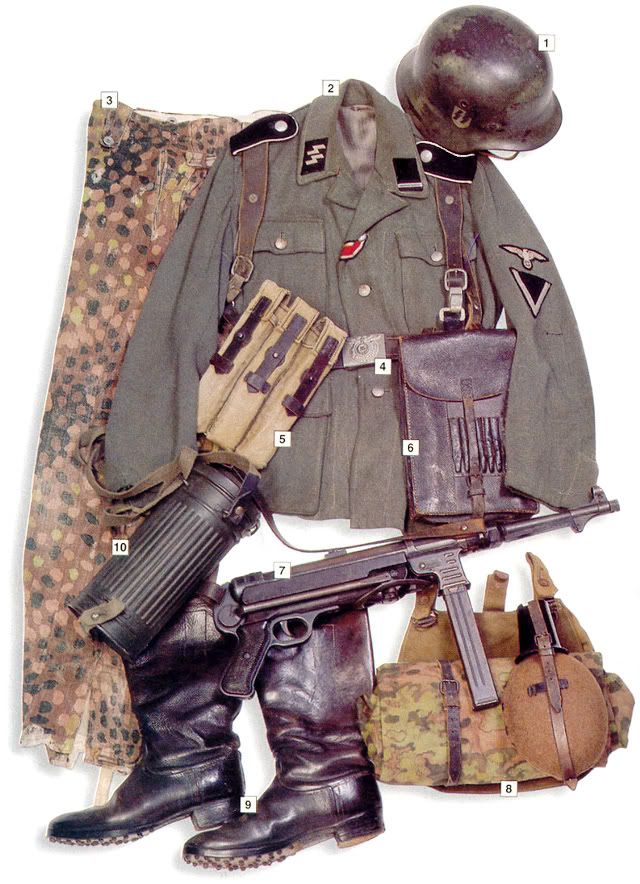 Waffen SS Sturmmann (Corporal), Normandy 1944
Waffen SS Sturmmann (Corporal), Normandy 194401 - M-40 helmet with SS badges
02 - M-43 SS Feldbluse, Sturmmann's insignia on the collar tabs and left sleeve, Iron Cross 2nd Class ribbon on the button
03 - trousers from the Drillichtanzug 43 uniform, in "Tupfenmuster" camo

04 - SS main belt with webbing
05 - Patronentasche für MP-Magazine, ammo pouches for MP-38/40
06 - map pouch
07 - 9 mm MP-40 SMG
08 - breadbag, canteen, Zeltbahn tent cloth
09 - boots
10 - gas mask canister
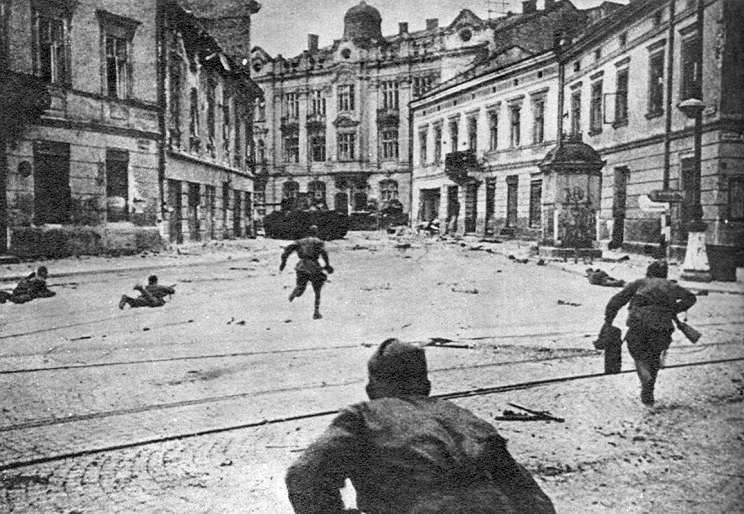 The 14th Waffen Grenadier Division of the SS (1st Galician) (German: 14. Waffen
The 14th Waffen Grenadier Division of the SS (1st Galician) (German: 14. Waffen  "Galician" (German: 14. SS-Freiwilligen
"Galician" (German: 14. SS-Freiwilligen  with a Ukrainian ethnic background but later also incorporated Slovaks,
with a Ukrainian ethnic background but later also incorporated Slovaks,  Czechs and Dutch volunteers and officers. Formed in 1943, it was largely destroyed in the battle of
Czechs and Dutch volunteers and officers. Formed in 1943, it was largely destroyed in the battle of  major Red Army operation to force the German troops from Ukraine and Eastern Poland. Launched in mid-July 1944, the Red Army achieved its set objectives by the end of August.
major Red Army operation to force the German troops from Ukraine and Eastern Poland. Launched in mid-July 1944, the Red Army achieved its set objectives by the end of August.
The offensive was composed of three smaller operations: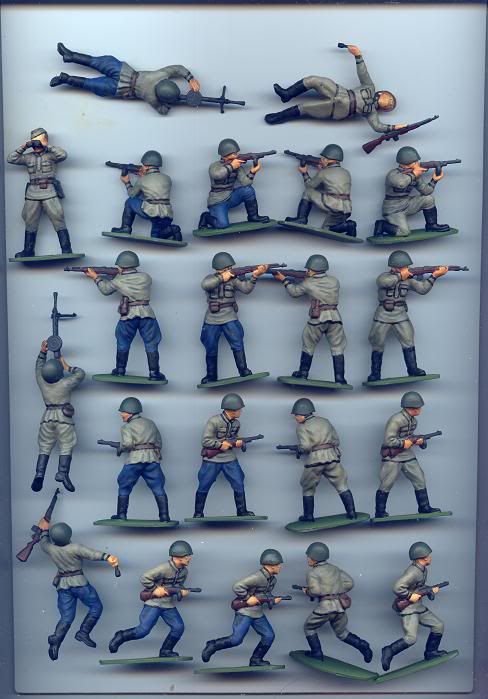

- Lviv Offensive Operation (13 July 1944 – 27 July 1944)
- Stanislav Offensive Operation (13 July 1944 – 27 July 1944)
- Sandomierz Offensive Operation (28 July 1944 – 29 August 1944)
The Lvov–Sandomierz Offensive is generally overshadowed by the overwhelming successes of the concurrently conductedOperation Bagration that led to the destruction of Army Group Centre. However, most of the Red Army and Red Air Forceresources were allocated,
However, most of the Red Army and Red Air Forceresources were allocated, not to Bagration's Belorussian operations, but the Lvov-Sandomierz operations
not to Bagration's Belorussian operations, but the Lvov-Sandomierz operations
The campaign was conducted as Maskirovka. By concentrating in southern Poland and Ukraine, the Soviets drew German mobile reserves southward, leaving Army Group Centre vulnerable to a concentrated assault.
By concentrating in southern Poland and Ukraine, the Soviets drew German mobile reserves southward, leaving Army Group Centre vulnerable to a concentrated assault.
When the Soviets launched their Bagration offensive against the Army Group, it would create a crisis in the central German front, which would then force the powerful German Panzer forces back to the central front, leaving the Soviets free to pursue their objectives in seizing the Vistula bridges and gaining a foothold in Romania
central front, leaving the Soviets free to pursue their objectives in seizing the Vistula bridges and gaining a foothold in Romania
By early June 1944, the forces of Generalfeldmarschall
Walter Model's Army Group North Ukraine had been pushed back beyond the Dniepr
had been pushed back beyond the Dniepr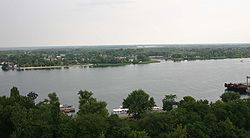 and were desperately clinging to the north-western corner of Ukraine. Joseph Stalin ordered the total liberation of
and were desperately clinging to the north-western corner of Ukraine. Joseph Stalin ordered the total liberation of Ukraine, and Stavka set in motion plans that would become the Lvov-Sandomierz Operation. In the
Ukraine, and Stavka set in motion plans that would become the Lvov-Sandomierz Operation. In the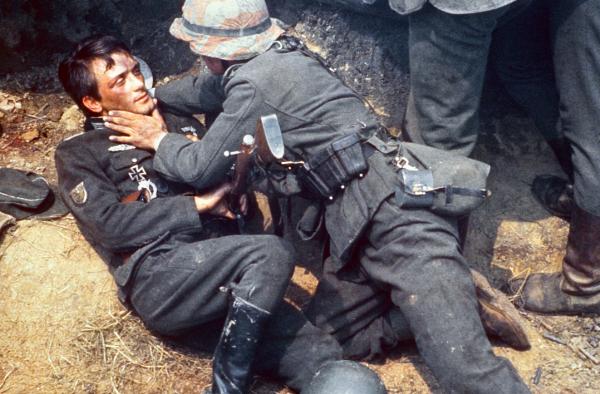 early planning stage, the offensive was known as the Lvov-Przemyśl Operation. The objective of the offensive was for Marshal Ivan Konev's1st Ukrainian Front
early planning stage, the offensive was known as the Lvov-Przemyśl Operation. The objective of the offensive was for Marshal Ivan Konev's1st Ukrainian Front to liberate Lviv and clear the German troops from Ukraine and capture a series of bridgeheads on the Vistula river.
to liberate Lviv and clear the German troops from Ukraine and capture a series of bridgeheads on the Vistula river.
 not to Bagration's Belorussian operations, but the Lvov-Sandomierz operations
not to Bagration's Belorussian operations, but the Lvov-Sandomierz operationsThe campaign was conducted as Maskirovka.
 By concentrating in southern Poland and Ukraine, the Soviets drew German mobile reserves southward, leaving Army Group Centre vulnerable to a concentrated assault.
By concentrating in southern Poland and Ukraine, the Soviets drew German mobile reserves southward, leaving Army Group Centre vulnerable to a concentrated assault.
When the Soviets launched their Bagration offensive against the Army Group, it would create a crisis in the central German front, which would then force the powerful German Panzer forces back to the

By early June 1944, the forces of Generalfeldmarschall
Walter Model's Army Group North Ukraine
 had been pushed back beyond the Dniepr
had been pushed back beyond the Dniepr and were desperately clinging to the north-western corner of Ukraine. Joseph Stalin ordered the total liberation of
and were desperately clinging to the north-western corner of Ukraine. Joseph Stalin ordered the total liberation of Ukraine, and Stavka set in motion plans that would become the Lvov-Sandomierz Operation. In the
Ukraine, and Stavka set in motion plans that would become the Lvov-Sandomierz Operation. In the early planning stage, the offensive was known as the Lvov-Przemyśl Operation. The objective of the offensive was for Marshal Ivan Konev's1st Ukrainian Front
early planning stage, the offensive was known as the Lvov-Przemyśl Operation. The objective of the offensive was for Marshal Ivan Konev's1st Ukrainian Front to liberate Lviv and clear the German troops from Ukraine and capture a series of bridgeheads on the Vistula river.
to liberate Lviv and clear the German troops from Ukraine and capture a series of bridgeheads on the Vistula river.
Stavka was also planning an even larger offensive, codenamed Operation Bagration to coincide with 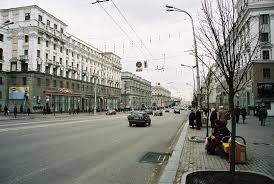 Konev's offensive. Operation Bagration objective was no less than the complete liberation of Belarus,
Konev's offensive. Operation Bagration objective was no less than the complete liberation of Belarus, and also to force the Wehrmacht out of eastern Poland. The Lvov-Sandomierz Strategic Offensive Operation was to be the means of denying
and also to force the Wehrmacht out of eastern Poland. The Lvov-Sandomierz Strategic Offensive Operation was to be the means of denying  transfer of reserves by the OKH to Army Group Centre, thus earning itself the lesser supporting role in the summer of 1944.
transfer of reserves by the OKH to Army Group Centre, thus earning itself the lesser supporting role in the summer of 1944.
While the Stavka was concluding its offensive plans Generalfeldmarschall Model was removed from command of the Army Group North Ukraine and replaced by Generaloberst Josef Harpe. Harpe's force included two Panzer Armies: the 1st Panzer Army, underGeneraloberst Gotthard Heinrici
Harpe's force included two Panzer Armies: the 1st Panzer Army, underGeneraloberst Gotthard Heinrici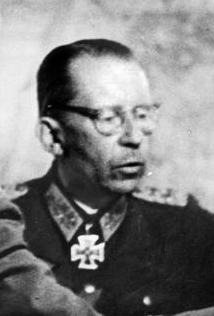 and the 4th Panzer Army under General der
and the 4th Panzer Army under General der  Panzertruppen Walther Nehring
Panzertruppen Walther Nehring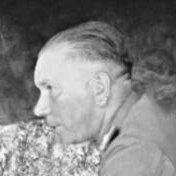 . Attached to the 1st Panzer Army was the Hungarian First Army.
. Attached to the 1st Panzer Army was the Hungarian First Army. Harpe could muster only 420 tanks, StuG's and other
Harpe could muster only 420 tanks, StuG's and other  assorted armoured vehicles. His Army Group comprised around 900,000 men; The Army Group was supported by the 700 aircraft of Luftflotte 4, including the veteran air units of VIII Fliegerkorps, and the
assorted armoured vehicles. His Army Group comprised around 900,000 men; The Army Group was supported by the 700 aircraft of Luftflotte 4, including the veteran air units of VIII Fliegerkorps, and the 300-400 aircraft of the nearby Luftflotte 6. However, due to the complicated inter-service chain of command, Harpe could not directly control the Luftwaffe units.
300-400 aircraft of the nearby Luftflotte 6. However, due to the complicated inter-service chain of command, Harpe could not directly control the Luftwaffe units.
 and also to force the Wehrmacht out of eastern Poland. The Lvov-Sandomierz Strategic Offensive Operation was to be the means of denying
and also to force the Wehrmacht out of eastern Poland. The Lvov-Sandomierz Strategic Offensive Operation was to be the means of denying  transfer of reserves by the OKH to Army Group Centre, thus earning itself the lesser supporting role in the summer of 1944.
transfer of reserves by the OKH to Army Group Centre, thus earning itself the lesser supporting role in the summer of 1944.
While the Stavka was concluding its offensive plans Generalfeldmarschall Model was removed from command of the Army Group North Ukraine and replaced by Generaloberst Josef Harpe.
 Harpe's force included two Panzer Armies: the 1st Panzer Army, underGeneraloberst Gotthard Heinrici
Harpe's force included two Panzer Armies: the 1st Panzer Army, underGeneraloberst Gotthard Heinrici and the 4th Panzer Army under General der
and the 4th Panzer Army under General der  . Attached to the 1st Panzer Army was the Hungarian First Army.
. Attached to the 1st Panzer Army was the Hungarian First Army. Harpe could muster only 420 tanks, StuG's and other
Harpe could muster only 420 tanks, StuG's and other  300-400 aircraft of the nearby Luftflotte 6. However, due to the complicated inter-service chain of command, Harpe could not directly control the Luftwaffe units.
300-400 aircraft of the nearby Luftflotte 6. However, due to the complicated inter-service chain of command, Harpe could not directly control the Luftwaffe units.
The 1st Ukrainian Front forces under Konev considerably outnumbered the Army Group North Ukraine.  The 1st Ukrainian Front could muster over 1,002,200 troops,some 2,050 tanks, about 16,000 guns and
The 1st Ukrainian Front could muster over 1,002,200 troops,some 2,050 tanks, about 16,000 guns and  mortars, and over 3,250 aircraft of the 2nd Air Armycommanded by General S.A. Krasovsky. In addition
mortars, and over 3,250 aircraft of the 2nd Air Armycommanded by General S.A. Krasovsky. In addition the morale of Konev's troops was extremely high following the recent victories in Ukraine. They had been on the offensive for almost a year, and were witnessing the collapse of Army Group Centre to their North.
the morale of Konev's troops was extremely high following the recent victories in Ukraine. They had been on the offensive for almost a year, and were witnessing the collapse of Army Group Centre to their North.
 The 1st Ukrainian Front could muster over 1,002,200 troops,some 2,050 tanks, about 16,000 guns and
The 1st Ukrainian Front could muster over 1,002,200 troops,some 2,050 tanks, about 16,000 guns and  mortars, and over 3,250 aircraft of the 2nd Air Armycommanded by General S.A. Krasovsky. In addition
mortars, and over 3,250 aircraft of the 2nd Air Armycommanded by General S.A. Krasovsky. In addition the morale of Konev's troops was extremely high following the recent victories in Ukraine. They had been on the offensive for almost a year, and were witnessing the collapse of Army Group Centre to their North.
the morale of Konev's troops was extremely high following the recent victories in Ukraine. They had been on the offensive for almost a year, and were witnessing the collapse of Army Group Centre to their North.
The 1st Ukrainian Front attack was to have two axes of attack. The first, aiming towards Rava-Ruska , was to be led by 3rd Guards, 1st Guards Tank and 13th Armies. The second pincer was aimed at Lviv itself, and was to be led by 60th, 38th, 3rd Guards Tank and 4th Tank Armies.
, was to be led by 3rd Guards, 1st Guards Tank and 13th Armies. The second pincer was aimed at Lviv itself, and was to be led by 60th, 38th, 3rd Guards Tank and 4th Tank Armies. 
The Red Army achieved massive superiority against the Germans by limiting their attacks to a front of only 26 kilometres. Konev had concentrated some 240 guns and mortars per kilometer of front.The northern attack towards Rava-Ruska began on 13 July 1944.
The 1st Ukrainian Front forces easily broke through near Horokhiv. The weakened Wehrmacht XLII Army Corpsmanaged to withdraw relatively intact using reinforced rearguard detachments. By nightfall, the 1st Ukrainian Front's 13th Army had penetrated the German lines to a depth of 20 kilometers. The 1st Ukrainian Front's breakthrough occurred to the north of the XIII Army Corps.
The weakened Wehrmacht XLII Army Corpsmanaged to withdraw relatively intact using reinforced rearguard detachments. By nightfall, the 1st Ukrainian Front's 13th Army had penetrated the German lines to a depth of 20 kilometers. The 1st Ukrainian Front's breakthrough occurred to the north of the XIII Army Corps.
 , was to be led by 3rd Guards, 1st Guards Tank and 13th Armies. The second pincer was aimed at Lviv itself, and was to be led by 60th, 38th, 3rd Guards Tank and 4th Tank Armies.
, was to be led by 3rd Guards, 1st Guards Tank and 13th Armies. The second pincer was aimed at Lviv itself, and was to be led by 60th, 38th, 3rd Guards Tank and 4th Tank Armies. 
The Red Army achieved massive superiority against the Germans by limiting their attacks to a front of only 26 kilometres. Konev had concentrated some 240 guns and mortars per kilometer of front.The northern attack towards Rava-Ruska began on 13 July 1944.
The 1st Ukrainian Front forces easily broke through near Horokhiv.
 The weakened Wehrmacht XLII Army Corpsmanaged to withdraw relatively intact using reinforced rearguard detachments. By nightfall, the 1st Ukrainian Front's 13th Army had penetrated the German lines to a depth of 20 kilometers. The 1st Ukrainian Front's breakthrough occurred to the north of the XIII Army Corps.
The weakened Wehrmacht XLII Army Corpsmanaged to withdraw relatively intact using reinforced rearguard detachments. By nightfall, the 1st Ukrainian Front's 13th Army had penetrated the German lines to a depth of 20 kilometers. The 1st Ukrainian Front's breakthrough occurred to the north of the XIII Army Corps.
On the 14 July 1944, the assault with the objective of liberating Lviv was begun to the south of the XIII Army Corps, which had positions near the town of Brody,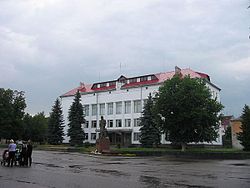 an area of Red Army failure earlier in the war. Red Army units had punched through the line near Horokhiv to the north and at Nusche in the south, leaving the XIII Corps dangerously exposed in a salient. The northern pincer towards Rava-Ruska
an area of Red Army failure earlier in the war. Red Army units had punched through the line near Horokhiv to the north and at Nusche in the south, leaving the XIII Corps dangerously exposed in a salient. The northern pincer towards Rava-Ruska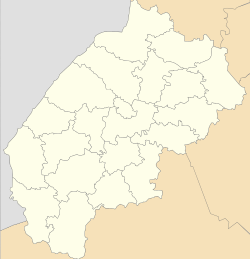 now began to split, turning several units of the 13th Army south in an attempt to encircle XIII Army Corps.
now began to split, turning several units of the 13th Army south in an attempt to encircle XIII Army Corps.
 an area of Red Army failure earlier in the war. Red Army units had punched through the line near Horokhiv to the north and at Nusche in the south, leaving the XIII Corps dangerously exposed in a salient. The northern pincer towards Rava-Ruska
an area of Red Army failure earlier in the war. Red Army units had punched through the line near Horokhiv to the north and at Nusche in the south, leaving the XIII Corps dangerously exposed in a salient. The northern pincer towards Rava-Ruska now began to split, turning several units of the 13th Army south in an attempt to encircle XIII Army Corps.
now began to split, turning several units of the 13th Army south in an attempt to encircle XIII Army Corps.
The northern forces soon encountered weak elements of the 291st and 340th Infantry Divisions, but these were quickly swept aside. On 15 July, Generaloberst Nehring, realising his 4th Panzer Army was in serious jeopardy, ordered his two reserve divisions, the 16th and 17th Panzer Divisions to counterattack near Horokiv and Druzhkopil in an attempt to halt the Soviet northern assault. The two divisions could muster only 43 tanks between them and despite their best efforts, the German counterattack soon bogged down.
The massively superior Red Army forces soon forced the two Panzer divisions to join the retreating infantry divisions. Konev ordered Mobile Group Baranov into the breach to help exploit the breakthrough.
The Mobile Group advanced quickly, under cover of air support, and over the next three days managed to capture the town of Kamionka Strumilowaand to seize and hold a bridgehead on the western bank of the Southern Bug River, thus
Strumilowaand to seize and hold a bridgehead on the western bank of the Southern Bug River, thus  cutting the XIII Army Corps' line of communication and cutting off their path of retreat.To the south, a
cutting the XIII Army Corps' line of communication and cutting off their path of retreat.To the south, a  major Red Army assault aimed at the juncture of the 1st and 4th Panzer Armies had been successfully repulsed on 14 July by the division-sized Korpsabteilung C.
major Red Army assault aimed at the juncture of the 1st and 4th Panzer Armies had been successfully repulsed on 14 July by the division-sized Korpsabteilung C.
The 1st Ukrainian Front shifted their attack further south, and after an immense artillery and air bombardment assaulted the already weakened 349th and 357th Infantry Divisions. The 349th Infantry Division collapsed under the assault, the survivors falling back in disarray. Due to the actions of Korpsabteilung C and 357th Infantry Division, the 1st Ukrainian Front breakthrough was only 3-4
Division collapsed under the assault, the survivors falling back in disarray. Due to the actions of Korpsabteilung C and 357th Infantry Division, the 1st Ukrainian Front breakthrough was only 3-4 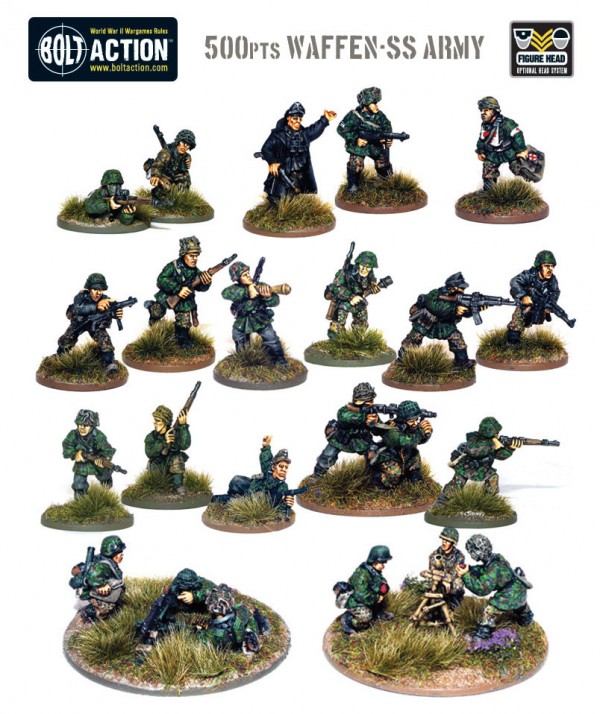 kilometers wide. Despite this, the 1st Ukrainian Front continued to advance towards the towns of Zolochiv
kilometers wide. Despite this, the 1st Ukrainian Front continued to advance towards the towns of Zolochiv  and Sasiv, driving a wedge between XIII Army Corps and the neighboring XLVIII Panzer Corps.
and Sasiv, driving a wedge between XIII Army Corps and the neighboring XLVIII Panzer Corps.

The massively superior Red Army forces soon forced the two Panzer divisions to join the retreating infantry divisions. Konev ordered Mobile Group Baranov into the breach to help exploit the breakthrough.
The Mobile Group advanced quickly, under cover of air support, and over the next three days managed to capture the town of Kamionka
 Strumilowaand to seize and hold a bridgehead on the western bank of the Southern Bug River, thus
Strumilowaand to seize and hold a bridgehead on the western bank of the Southern Bug River, thus  cutting the XIII Army Corps' line of communication and cutting off their path of retreat.To the south, a
cutting the XIII Army Corps' line of communication and cutting off their path of retreat.To the south, a  major Red Army assault aimed at the juncture of the 1st and 4th Panzer Armies had been successfully repulsed on 14 July by the division-sized Korpsabteilung C.
major Red Army assault aimed at the juncture of the 1st and 4th Panzer Armies had been successfully repulsed on 14 July by the division-sized Korpsabteilung C.The 1st Ukrainian Front shifted their attack further south, and after an immense artillery and air bombardment assaulted the already weakened 349th and 357th Infantry Divisions. The 349th Infantry
 Division collapsed under the assault, the survivors falling back in disarray. Due to the actions of Korpsabteilung C and 357th Infantry Division, the 1st Ukrainian Front breakthrough was only 3-4
Division collapsed under the assault, the survivors falling back in disarray. Due to the actions of Korpsabteilung C and 357th Infantry Division, the 1st Ukrainian Front breakthrough was only 3-4  kilometers wide. Despite this, the 1st Ukrainian Front continued to advance towards the towns of Zolochiv
kilometers wide. Despite this, the 1st Ukrainian Front continued to advance towards the towns of Zolochiv  and Sasiv, driving a wedge between XIII Army Corps and the neighboring XLVIII Panzer Corps.
and Sasiv, driving a wedge between XIII Army Corps and the neighboring XLVIII Panzer Corps.
German artillery from both Сorps and the 18th Artillery Division began saturating the narrow salient, dubbed the Koltiv Corridor. A hasty counterattack by the 1st Panzer and 8th Panzer Divisions took place, accompanied by elements of the 14th Waffen Grenadier Division of the SS Galizien (1st Ukrainian).
While the Galizien and 1st Panzer fought well, the 8th Panzer division got lost, and found itself in the XIII Army Corps area. Cut off from the XLVIII Panzer Corps and the 1st Panzer Division, it was unable to take part in the attack. Despite initial gains, the 1st Ukrainian Front finally managed to halt the German attack, with the help of the 2nd Air Army which dropped 17,200 bombs on the attacking panzers. The absence of 8th Panzer Division meant that the attack was doomed to fail. The commander of 8th Panzer had ignored explicit orders, and attempted to lead his force on a short cut. Instead, the division was strung out on the Zolochiv - Zboriv section of the Lviv - Ternopil road
Despite initial gains, the 1st Ukrainian Front finally managed to halt the German attack, with the help of the 2nd Air Army which dropped 17,200 bombs on the attacking panzers. The absence of 8th Panzer Division meant that the attack was doomed to fail. The commander of 8th Panzer had ignored explicit orders, and attempted to lead his force on a short cut. Instead, the division was strung out on the Zolochiv - Zboriv section of the Lviv - Ternopil road , and suffered immense losses from Red Air Force Il-2s. Despite this, the southern attack was slowing.
, and suffered immense losses from Red Air Force Il-2s. Despite this, the southern attack was slowing.

While the Galizien and 1st Panzer fought well, the 8th Panzer division got lost, and found itself in the XIII Army Corps area. Cut off from the XLVIII Panzer Corps and the 1st Panzer Division, it was unable to take part in the attack.
 Despite initial gains, the 1st Ukrainian Front finally managed to halt the German attack, with the help of the 2nd Air Army which dropped 17,200 bombs on the attacking panzers. The absence of 8th Panzer Division meant that the attack was doomed to fail. The commander of 8th Panzer had ignored explicit orders, and attempted to lead his force on a short cut. Instead, the division was strung out on the Zolochiv - Zboriv section of the Lviv - Ternopil road
Despite initial gains, the 1st Ukrainian Front finally managed to halt the German attack, with the help of the 2nd Air Army which dropped 17,200 bombs on the attacking panzers. The absence of 8th Panzer Division meant that the attack was doomed to fail. The commander of 8th Panzer had ignored explicit orders, and attempted to lead his force on a short cut. Instead, the division was strung out on the Zolochiv - Zboriv section of the Lviv - Ternopil road , and suffered immense losses from Red Air Force Il-2s. Despite this, the southern attack was slowing.
, and suffered immense losses from Red Air Force Il-2s. Despite this, the southern attack was slowing.
On the 16 July, Konev took a great risk and committed Lieutenant General Pavel Rybalko's 3rd Guards Tank Army to the southern assault. This meant that the Army would have to travel through the narrow Koltiv Corridor, constantly under artillery fire and fierce German counterattacks. The 3rd Guards Tank tilted the balance in the Lviv direction, and soon the Soviet advance resumed its advance west. The commander of the XIII Army Corps realised that his Corps needed to retreat if it were to avoid encirclement. The order was given for all Corps units to fall back to the Prinz-Eugen-Stellung, a series of unmanned defensive positions built in June 1944 which ran partly along the Strypa river about 35 km west of Ternopil. Strong 1st Ukrainian Front attacks throughout 17 July succeeded in capturing parts of the Prinz-Eugen-Stellung.
about 35 km west of Ternopil. Strong 1st Ukrainian Front attacks throughout 17 July succeeded in capturing parts of the Prinz-Eugen-Stellung.
The 14th Waffen Grenadier Division of the SS joined the combat in an attempt to recapture these lost positions, but after some success ran into a unit of Soviet IS-2 tanks which put an end to the SS advance. Despite repeated warnings from his subordinates, the Corps commander, General der Infanterie Arthur Hauffe,
which put an end to the SS advance. Despite repeated warnings from his subordinates, the Corps commander, General der Infanterie Arthur Hauffe, did not order further withdrawal, condemning the three XIII Army Corps divisions and Korps-Abteilung C in the Brody salient to their fate.[9]
did not order further withdrawal, condemning the three XIII Army Corps divisions and Korps-Abteilung C in the Brody salient to their fate.[9]
 about 35 km west of Ternopil. Strong 1st Ukrainian Front attacks throughout 17 July succeeded in capturing parts of the Prinz-Eugen-Stellung.
about 35 km west of Ternopil. Strong 1st Ukrainian Front attacks throughout 17 July succeeded in capturing parts of the Prinz-Eugen-Stellung. The 14th Waffen Grenadier Division of the SS joined the combat in an attempt to recapture these lost positions, but after some success ran into a unit of Soviet IS-2 tanks
 which put an end to the SS advance. Despite repeated warnings from his subordinates, the Corps commander, General der Infanterie Arthur Hauffe,
which put an end to the SS advance. Despite repeated warnings from his subordinates, the Corps commander, General der Infanterie Arthur Hauffe,
On 18 July, renewed 1st Ukrainian Front attacks resulted in a breakthrough in the Lviv operational direction. Late in the day, the 1st Ukrainian Front spearheads met near the town of Busk.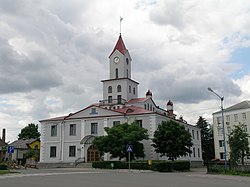 The encirclement was complete. 45,000 men of the XIII Army Corps were trapped around Brody, and a 200 km breach had been created along the Army Group North Ukraine's front.
The encirclement was complete. 45,000 men of the XIII Army Corps were trapped around Brody, and a 200 km breach had been created along the Army Group North Ukraine's front.
 The encirclement was complete. 45,000 men of the XIII Army Corps were trapped around Brody, and a 200 km breach had been created along the Army Group North Ukraine's front.
The encirclement was complete. 45,000 men of the XIII Army Corps were trapped around Brody, and a 200 km breach had been created along the Army Group North Ukraine's front.
For the men trapped at Brody, help would not come. Despite several desperate attacks by the exhausted and under strength forces of XLVIII Panzer Corps and XXIV Panzer Corps, the 1st Ukrainian Front cordon continued to tighten. Under continued 1st Ukrainian Front attacks, Harpe ordered his forces to fall back, abandoning the trapped XIII Army Corps. Under constant artillery and aerial bombardment, the beleaguered forces made several breakout attempts, but these were easily repulsed by the 1st Ukrainian Front armoured forces and the Germans suffered heavy casualties. On 22 July, a 1st Ukrainian Front attack cut the pocket in two, and by nightfall almost all resistance had been
but these were easily repulsed by the 1st Ukrainian Front armoured forces and the Germans suffered heavy casualties. On 22 July, a 1st Ukrainian Front attack cut the pocket in two, and by nightfall almost all resistance had been  eliminated. The scattered survivors broke up into small groups and attempted to break out. Few reached Axis lines, but among them were 3,500 men of the Galizien SS. Before the operation, the division had numbered 11,000 men. Konev was elated at the unexpected success of the operation. Harpe's Army Group was falling back; the 4th Panzer Army to the Vistula River and the 1st Panzer Army along with 1st Hungarian Army to the area around the Carpathian Mountains.
eliminated. The scattered survivors broke up into small groups and attempted to break out. Few reached Axis lines, but among them were 3,500 men of the Galizien SS. Before the operation, the division had numbered 11,000 men. Konev was elated at the unexpected success of the operation. Harpe's Army Group was falling back; the 4th Panzer Army to the Vistula River and the 1st Panzer Army along with 1st Hungarian Army to the area around the Carpathian Mountains.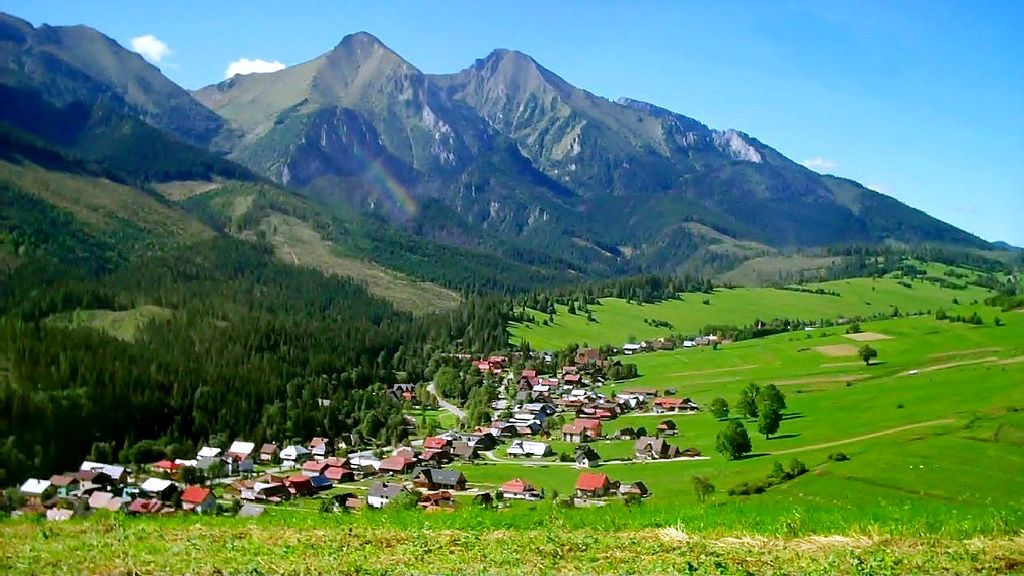
 but these were easily repulsed by the 1st Ukrainian Front armoured forces and the Germans suffered heavy casualties. On 22 July, a 1st Ukrainian Front attack cut the pocket in two, and by nightfall almost all resistance had been
but these were easily repulsed by the 1st Ukrainian Front armoured forces and the Germans suffered heavy casualties. On 22 July, a 1st Ukrainian Front attack cut the pocket in two, and by nightfall almost all resistance had been  eliminated. The scattered survivors broke up into small groups and attempted to break out. Few reached Axis lines, but among them were 3,500 men of the Galizien SS. Before the operation, the division had numbered 11,000 men. Konev was elated at the unexpected success of the operation. Harpe's Army Group was falling back; the 4th Panzer Army to the Vistula River and the 1st Panzer Army along with 1st Hungarian Army to the area around the Carpathian Mountains.
eliminated. The scattered survivors broke up into small groups and attempted to break out. Few reached Axis lines, but among them were 3,500 men of the Galizien SS. Before the operation, the division had numbered 11,000 men. Konev was elated at the unexpected success of the operation. Harpe's Army Group was falling back; the 4th Panzer Army to the Vistula River and the 1st Panzer Army along with 1st Hungarian Army to the area around the Carpathian Mountains.
Lviv itself was occupied again by the Soviets on 26 July, the first time being in September 1939 during the Nazi-Soviet alliance and joint invasion of Poland. This time, the city was retaken by the 1st Ukrainian Front, a Soviet force, relatively easily. The Germans had been completely forced out from Western Ukraine. Seeing this success, Stavka issued new orders on 28 July. Konev was to attack across the Vistula and to capture the city of Sandomierz,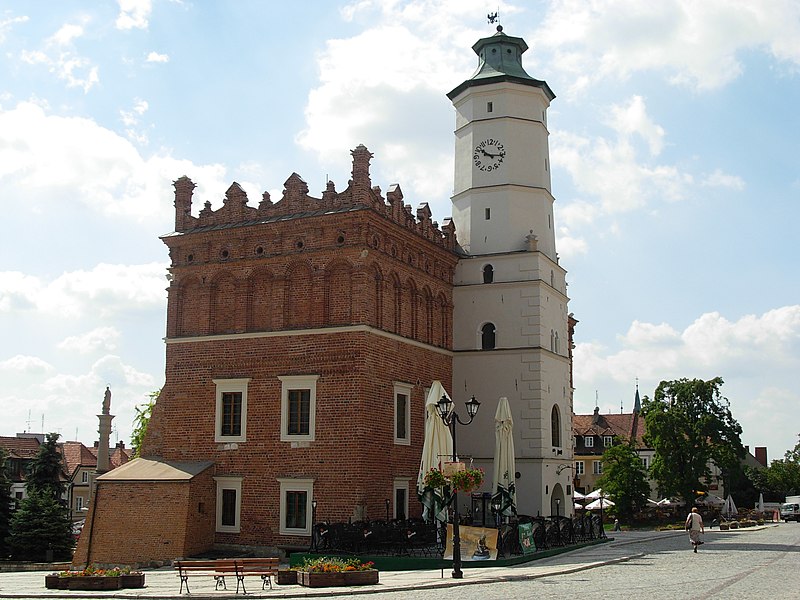 in Nazi-occupied southern Poland. Ukrainian hopes of independence were squashed amidst the overwhelming force of the Soviets, much like in Estonia, Latvia, and Lithuania. The Ukrainian Insurgent Army, UPA, would continue waging a guerrilla war against the Soviets well into the 1950s.The renewed Soviet offensive got underway on 29 July, with Konev's spearheads quickly reaching the Vistula and establishing a strong bridgehead near Baranów Sandomierski.
in Nazi-occupied southern Poland. Ukrainian hopes of independence were squashed amidst the overwhelming force of the Soviets, much like in Estonia, Latvia, and Lithuania. The Ukrainian Insurgent Army, UPA, would continue waging a guerrilla war against the Soviets well into the 1950s.The renewed Soviet offensive got underway on 29 July, with Konev's spearheads quickly reaching the Vistula and establishing a strong bridgehead near Baranów Sandomierski.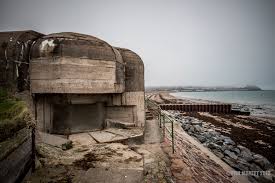 However, strong German counterattacks near Sandomierz prevented further expansion of the Soviet bridgehead. In early August, Harpe gained some respite. Five divisions, including one Panzer division, were transferred from Army Group South Ukraine. These were immediately thrown into action around Sandomierz. Soon after, another five German divisions, three Hungarian divisions, six StuG brigades and the 501st Heavy Tank Battalion (equipped with Tiger II tanks)
However, strong German counterattacks near Sandomierz prevented further expansion of the Soviet bridgehead. In early August, Harpe gained some respite. Five divisions, including one Panzer division, were transferred from Army Group South Ukraine. These were immediately thrown into action around Sandomierz. Soon after, another five German divisions, three Hungarian divisions, six StuG brigades and the 501st Heavy Tank Battalion (equipped with Tiger II tanks) were placed under Harpe's command.
were placed under Harpe's command.
 in Nazi-occupied southern Poland. Ukrainian hopes of independence were squashed amidst the overwhelming force of the Soviets, much like in Estonia, Latvia, and Lithuania. The Ukrainian Insurgent Army, UPA, would continue waging a guerrilla war against the Soviets well into the 1950s.The renewed Soviet offensive got underway on 29 July, with Konev's spearheads quickly reaching the Vistula and establishing a strong bridgehead near Baranów Sandomierski.
in Nazi-occupied southern Poland. Ukrainian hopes of independence were squashed amidst the overwhelming force of the Soviets, much like in Estonia, Latvia, and Lithuania. The Ukrainian Insurgent Army, UPA, would continue waging a guerrilla war against the Soviets well into the 1950s.The renewed Soviet offensive got underway on 29 July, with Konev's spearheads quickly reaching the Vistula and establishing a strong bridgehead near Baranów Sandomierski. were placed under Harpe's command.
were placed under Harpe's command.
Large-scale German counterattacks were launched in an attempt to throw the Soviets back across the Vistula. Using the towns of Mielec 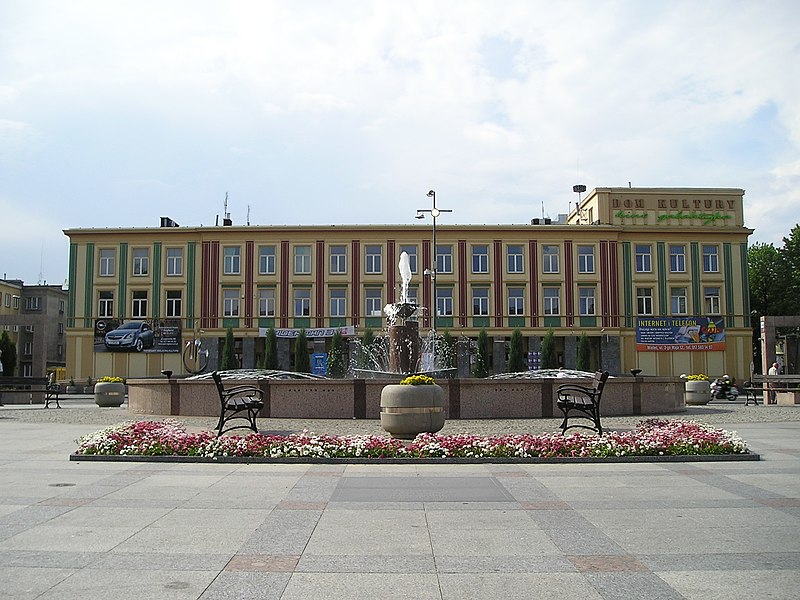 and Tarnobrzeg on the eastern bank of the river as bases, these attacks caused heavy casualties to the Soviet forces. By mid-August, Konev's spearhead, the 6th Guards Tank Corps had only 67 tanks remaining. The Germans launched a fierce counterattack with the 501st Heavy Tank Battalion and the 6th Panzer Division, totaling around 140 tanks including 20 Tiger IIs. Despite being heavily outnumbered, the 6th Guards held the bridgehead, knocking out 10 Tiger IIs. By 16 August, the German counterattacks were beginning to lose steam, and Rybalko, the commander of the bridgehead, was able to expand the Soviet controlled area by a depth of 120 kilometers, capturing the city of Sandomierz. With both sides exhausted, the fighting died down and the Lvov–Sandomierz Offensive was deemed complete.
and Tarnobrzeg on the eastern bank of the river as bases, these attacks caused heavy casualties to the Soviet forces. By mid-August, Konev's spearhead, the 6th Guards Tank Corps had only 67 tanks remaining. The Germans launched a fierce counterattack with the 501st Heavy Tank Battalion and the 6th Panzer Division, totaling around 140 tanks including 20 Tiger IIs. Despite being heavily outnumbered, the 6th Guards held the bridgehead, knocking out 10 Tiger IIs. By 16 August, the German counterattacks were beginning to lose steam, and Rybalko, the commander of the bridgehead, was able to expand the Soviet controlled area by a depth of 120 kilometers, capturing the city of Sandomierz. With both sides exhausted, the fighting died down and the Lvov–Sandomierz Offensive was deemed complete.
 and Tarnobrzeg on the eastern bank of the river as bases, these attacks caused heavy casualties to the Soviet forces. By mid-August, Konev's spearhead, the 6th Guards Tank Corps had only 67 tanks remaining. The Germans launched a fierce counterattack with the 501st Heavy Tank Battalion and the 6th Panzer Division, totaling around 140 tanks including 20 Tiger IIs. Despite being heavily outnumbered, the 6th Guards held the bridgehead, knocking out 10 Tiger IIs. By 16 August, the German counterattacks were beginning to lose steam, and Rybalko, the commander of the bridgehead, was able to expand the Soviet controlled area by a depth of 120 kilometers, capturing the city of Sandomierz. With both sides exhausted, the fighting died down and the Lvov–Sandomierz Offensive was deemed complete.
and Tarnobrzeg on the eastern bank of the river as bases, these attacks caused heavy casualties to the Soviet forces. By mid-August, Konev's spearhead, the 6th Guards Tank Corps had only 67 tanks remaining. The Germans launched a fierce counterattack with the 501st Heavy Tank Battalion and the 6th Panzer Division, totaling around 140 tanks including 20 Tiger IIs. Despite being heavily outnumbered, the 6th Guards held the bridgehead, knocking out 10 Tiger IIs. By 16 August, the German counterattacks were beginning to lose steam, and Rybalko, the commander of the bridgehead, was able to expand the Soviet controlled area by a depth of 120 kilometers, capturing the city of Sandomierz. With both sides exhausted, the fighting died down and the Lvov–Sandomierz Offensive was deemed complete.
After World War I and the dissolution of Austria–Hungary, the territory of Eastern Galicia ( Halychyna), populated by a Ukrainian majority but with a large Polish minority, was incorporated into Poland following the Polish–Ukrainian War. Between the wars, the political allegiances of Ukrainians in eastern Galicia were divided between moderate national democrats and the more radical Organization of Ukrainian Nationalists (nazis)
Halychyna), populated by a Ukrainian majority but with a large Polish minority, was incorporated into Poland following the Polish–Ukrainian War. Between the wars, the political allegiances of Ukrainians in eastern Galicia were divided between moderate national democrats and the more radical Organization of Ukrainian Nationalists (nazis)
The latter group itself splintered into two factions, the more moderate OUN-M led by Andriy Melnyk with close ties to German intelligence (Abwehr), and the more radical OUN-B led by Stepan Bandera.
with close ties to German intelligence (Abwehr), and the more radical OUN-B led by Stepan Bandera. When Poland was divided between Germany and the Soviet Union under the terms of the Molotov–Ribbentrop Pact in 1939, the territory of eastern Galicia was annexed to Soviet Ukraine. In 1941 it was occupied by Germany.
When Poland was divided between Germany and the Soviet Union under the terms of the Molotov–Ribbentrop Pact in 1939, the territory of eastern Galicia was annexed to Soviet Ukraine. In 1941 it was occupied by Germany.
 Halychyna), populated by a Ukrainian majority but with a large Polish minority, was incorporated into Poland following the Polish–Ukrainian War. Between the wars, the political allegiances of Ukrainians in eastern Galicia were divided between moderate national democrats and the more radical Organization of Ukrainian Nationalists (nazis)
Halychyna), populated by a Ukrainian majority but with a large Polish minority, was incorporated into Poland following the Polish–Ukrainian War. Between the wars, the political allegiances of Ukrainians in eastern Galicia were divided between moderate national democrats and the more radical Organization of Ukrainian Nationalists (nazis)The latter group itself splintered into two factions, the more moderate OUN-M led by Andriy Melnyk
 with close ties to German intelligence (Abwehr), and the more radical OUN-B led by Stepan Bandera.
with close ties to German intelligence (Abwehr), and the more radical OUN-B led by Stepan Bandera. When Poland was divided between Germany and the Soviet Union under the terms of the Molotov–Ribbentrop Pact in 1939, the territory of eastern Galicia was annexed to Soviet Ukraine. In 1941 it was occupied by Germany.
When Poland was divided between Germany and the Soviet Union under the terms of the Molotov–Ribbentrop Pact in 1939, the territory of eastern Galicia was annexed to Soviet Ukraine. In 1941 it was occupied by Germany.
Ukrainian leaders of various political persuasions recognised the need for a trained armed force. The Germans had earlier considered the formation of an armed force made up of Slavic people, but they decided this to be unacceptable as they regarded Slavs as sub-humans (untermenschen) compared to the Germanic ubermenschen master race. At the beginning of 1943, growing losses inclined Nazi leaders to alter their initial opinions.
The idea to organize a division of volunteers from Galicia was proposed by the German Governor of District Galicia, Dr. Otto von Wächter. He suggested creation of a Waffen-SSdivision composed of Galician volunteers and designed for regular combat on the Eastern Front.
The creation of 14th Voluntary Division SS Galizien was announced in April 1943 at ceremonies throughout Galicia. At least 50 documents including contemporary newspaper clippings, radio broadcasts and speeches etc. record the date of 28 April.
By June 1943 the first phase of recruitment had taken place. Initially Wächter's proposal (which he was certain would be supported by Ukrainian circles) was rejected. In Berlin Wächter was able to get support from Himmler who made the stipulation that the division would only made up of Galicians, who Himmler considered "more Aryan-like".
The terms "Ukrainian", "Ukraine", could not be used when addressing the division, stressing the Imperial Austro-Hungarian heritage of the term "Galizien".
David Marples suggests that the division was titled "Galicia" to ensure stricter German control to avoid direct use of inflammatory term "Ukrainian".
The creation of 14th Voluntary Division SS Galizien was announced in April 1943 at ceremonies throughout Galicia. At least 50 documents including contemporary newspaper clippings, radio broadcasts and speeches etc. record the date of 28 April.
By June 1943 the first phase of recruitment had taken place. Initially Wächter's proposal (which he was certain would be supported by Ukrainian circles) was rejected. In Berlin Wächter was able to get support from Himmler who made the stipulation that the division would only made up of Galicians, who Himmler considered "more Aryan-like".
The terms "Ukrainian", "Ukraine", could not be used when addressing the division, stressing the Imperial Austro-Hungarian heritage of the term "Galizien".
David Marples suggests that the division was titled "Galicia" to ensure stricter German control to avoid direct use of inflammatory term "Ukrainian".
Wächter approached the Ukrainian Central Committee, a nonpolitical social welfare organization headed by Volodymyr Kubiyovych  which supported the idea of the formation of the division
which supported the idea of the formation of the division
The Ukrainian Catholic Church demanded the presence of its chaplains in the division, which was usually not permitted by Germans. Thus the Ukrainian division along with the Bosnian one became notable exceptions.
 which supported the idea of the formation of the division
which supported the idea of the formation of the divisionThe Ukrainian Catholic Church demanded the presence of its chaplains in the division, which was usually not permitted by Germans. Thus the Ukrainian division along with the Bosnian one became notable exceptions.
Germans made two political concessions: It was stipulated that the division shall not be used to fight Western Allies, and would be used exclusively to "fight Bolsheviks".
The other concession was in that its oath of allegiance to Hitler was conditional on the fight against Bolshevism and in the fact that Christian (mostly Ukrainian Greek Catholic Church and Ukrainian Orthodox) chaplains were integrated into the units and allowed to function (in the Waffen-SS, only the Bosnian division and Sturmbrigade Wallonien had a clerical presence).
The latter condition was instituted at the insistence of the division's organizers in order to minimize the risk of Nazi demoralization amongst the soldiers.Indeed, Nazi indoctrination was absent within the division.
The other concession was in that its oath of allegiance to Hitler was conditional on the fight against Bolshevism and in the fact that Christian (mostly Ukrainian Greek Catholic Church and Ukrainian Orthodox) chaplains were integrated into the units and allowed to function (in the Waffen-SS, only the Bosnian division and Sturmbrigade Wallonien had a clerical presence).
The latter condition was instituted at the insistence of the division's organizers in order to minimize the risk of Nazi demoralization amongst the soldiers.Indeed, Nazi indoctrination was absent within the division.
The creation of foreign SS units had been carried out previously in the name of fighting against communism; with French, Dutch, Latvian,Estonian, Croatian, and Belarusian units, among others, had been created. The creation of a Ukrainian SS division was perceived by many in Ukraine as a step towards the attainment of Ukrainian independence and attracted many volunteers.
The Division enjoyed support from multiple political and religious groups within the western Ukrainian community. The Division's prime organizer and highest ranking Ukrainian officer, Dmytro Paliiv, had been the leader of a small legal political party in the Second Polish Republic. Many of his colleagues had been members of the pre-war moderate, left-leaning democratic UNDO movement that before the war had also been opposed to the authoritarian Organization of Ukrainian Nationalists.
had been the leader of a small legal political party in the Second Polish Republic. Many of his colleagues had been members of the pre-war moderate, left-leaning democratic UNDO movement that before the war had also been opposed to the authoritarian Organization of Ukrainian Nationalists.
The Division also obtained moral support from officers of the exiled Polish-allied Ukrainian National Republic such as General Mykhailo Omelianovych-Pavlenko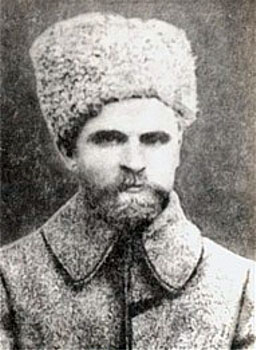 . The Division was also strongly supported byAndriy Melnyk's
. The Division was also strongly supported byAndriy Melnyk's  moderate faction of the Organization of Ukrainian Nationalists, who saw it as a counterweight to the extremist Banderist-dominated UPA.
moderate faction of the Organization of Ukrainian Nationalists, who saw it as a counterweight to the extremist Banderist-dominated UPA.
The Division also obtained moral support from officers of the exiled Polish-allied Ukrainian National Republic such as General Mykhailo Omelianovych-Pavlenko
 . The Division was also strongly supported byAndriy Melnyk's
. The Division was also strongly supported byAndriy Melnyk's  moderate faction of the Organization of Ukrainian Nationalists, who saw it as a counterweight to the extremist Banderist-dominated UPA.
moderate faction of the Organization of Ukrainian Nationalists, who saw it as a counterweight to the extremist Banderist-dominated UPA.
The Bandera faction of the Organization of Ukrainian Nationalists (OUN-B) strongly opposed the idea of creating the division, in part because it was an organization outside its control, and claimed in its propaganda that the division was to be used by the Germans as cannon fodder.
Nevertheless, it did not interfere in its formation and once the division was formed it sent some of its members, a number of whom would obtain prominent positions, into the division in order for them to gain military training and to prevent it from completely getting out of their hands. Despite this infiltration, Bandera's OUN failed to gain control over the division.
Nevertheless, it did not interfere in its formation and once the division was formed it sent some of its members, a number of whom would obtain prominent positions, into the division in order for them to gain military training and to prevent it from completely getting out of their hands. Despite this infiltration, Bandera's OUN failed to gain control over the division.
It also had the support of both the Ukrainian Greek Catholic Church and the Ukrainian Autocephalous Orthodox Church. Among its members was a son of Mstyslav Skrypnyk , theOrthodox Bishop of Kiev.
, theOrthodox Bishop of Kiev.
 , theOrthodox Bishop of Kiev.
, theOrthodox Bishop of Kiev.
The Division SS "Galizien" was commanded by German, Austrian and Ukrainian officers who were delegated to the division.

Training for the recruits began within the SS-Special Purpose Training Battalion (SS-Ausbildungs-Battalion z.b.V, commanded by SS Sturmbannfuher Bernard Bartlet while the man appointed to oversee the raising of the Division was General Walter Schimana (until October 1943). Schimana never commanded the division as it up to the point of his departure it was still a training battalion, staffed mostly by temporary training personnel. From 20 November 1943 SS-Brigadier General Fritz Freitag.
(until October 1943). Schimana never commanded the division as it up to the point of his departure it was still a training battalion, staffed mostly by temporary training personnel. From 20 November 1943 SS-Brigadier General Fritz Freitag. Captain Wolf Dietrich Heike
Captain Wolf Dietrich Heike  (transferred from the Wehrmacht) was the chief of staff from January 1944. All regimental commanders were Germans.
(transferred from the Wehrmacht) was the chief of staff from January 1944. All regimental commanders were Germans.
 (until October 1943). Schimana never commanded the division as it up to the point of his departure it was still a training battalion, staffed mostly by temporary training personnel. From 20 November 1943 SS-Brigadier General Fritz Freitag.
(until October 1943). Schimana never commanded the division as it up to the point of his departure it was still a training battalion, staffed mostly by temporary training personnel. From 20 November 1943 SS-Brigadier General Fritz Freitag. Captain Wolf Dietrich Heike
Captain Wolf Dietrich Heike
81,999 men enlisted for service in the division. There was a "mandatory" requirement for certain large categories of the population to register for service—for example all males between 18–25 years old), former soldiers born between 1900 and 1925
and all former officers and non-commissioned officers who had served in any kind of army
Consequently it is erroneous to suggest that all those who enlisted were "volunteers". Of these, 42,000 were called up during the first "recruitment phase" which took place in May and June 1943 from which only 27,000 were deemed fit for military service and 13,000 were recruited. To boost the recruitment figures the height minimum requirement was lowered from 1.65m to 1.61m.
and all former officers and non-commissioned officers who had served in any kind of army
Consequently it is erroneous to suggest that all those who enlisted were "volunteers". Of these, 42,000 were called up during the first "recruitment phase" which took place in May and June 1943 from which only 27,000 were deemed fit for military service and 13,000 were recruited. To boost the recruitment figures the height minimum requirement was lowered from 1.65m to 1.61m.
In mid February 1944 the division received an order to form a battle group known as SS Kampfgruppe Beyersdorff for action against Soviet and Polish partisans. It operated in the Zamość area together with elements of the 5th Regiment, while elements of the 4th Regiment were sent to Brody. The SS Kampfgruppe performed its duty well enough that it earned the rare praise of German Field Marshal Walter Model.
together with elements of the 5th Regiment, while elements of the 4th Regiment were sent to Brody. The SS Kampfgruppe performed its duty well enough that it earned the rare praise of German Field Marshal Walter Model.
 together with elements of the 5th Regiment, while elements of the 4th Regiment were sent to Brody. The SS Kampfgruppe performed its duty well enough that it earned the rare praise of German Field Marshal Walter Model.
together with elements of the 5th Regiment, while elements of the 4th Regiment were sent to Brody. The SS Kampfgruppe performed its duty well enough that it earned the rare praise of German Field Marshal Walter Model.
In July the division was sent to the area of Brody, where heavy combat was under way, and attached to the 13th Army Corps.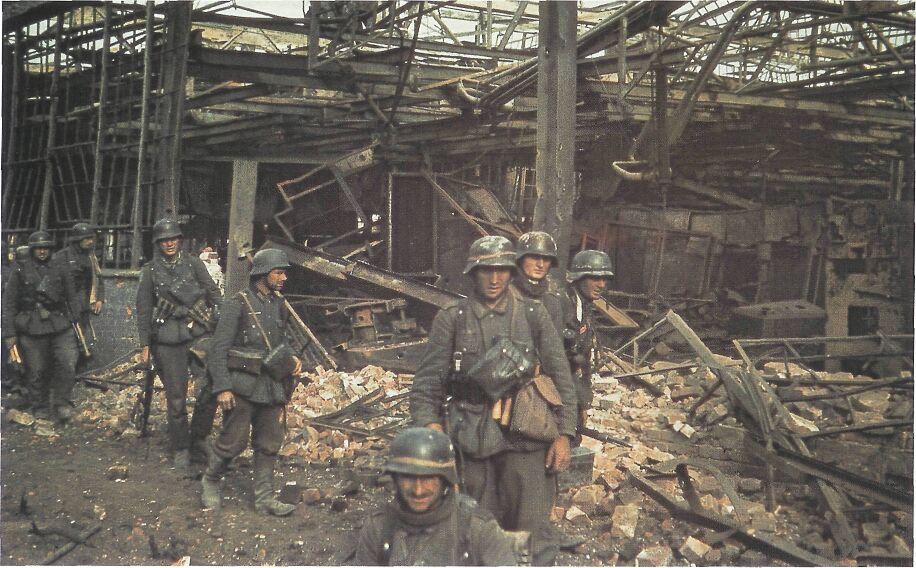
Together with six under-strength German infantry divisions, the Galicia Division was responsible for holding a frontage of approximately 80 kilometres.
On 8 July, the 13th Corps was transferred to the 1st Panzer Army.
The Galician Division was placed in reserve. Deployed at Brody were the division's 29th, 30th, 31st regiments, a fusilier and engineering battalion, and its artillery regiment. The 14th SS Field Replacement Battalion was deployed fifteen miles behind the other units.

Together with six under-strength German infantry divisions, the Galicia Division was responsible for holding a frontage of approximately 80 kilometres.
On 8 July, the 13th Corps was transferred to the 1st Panzer Army.
The Galician Division was placed in reserve. Deployed at Brody were the division's 29th, 30th, 31st regiments, a fusilier and engineering battalion, and its artillery regiment. The 14th SS Field Replacement Battalion was deployed fifteen miles behind the other units.
On 13 July, Soviet forces under the command of Marshal Ivan Konev launched their attack. By the next day, they routed a German division to the north of the 13th Corps and swept back an attempted German counterattack
On 15 July, the 1st and 8th Panzer Divisions along with the Galicia Division bore the brunt of a fierce assault by the Soviet Second Air Army, who in only a five-hour period flew 3,288 aircraft sorties and dropped 102 tons of bombs on them as they attempted a counterattack.
On 18 July, the division's Field Replacement Battalion was destroyed with its remnants fleeing west, whilst the remainder of 13th Corps, consisting of over 30,000 German and Ukrainian soldiers, was surrounded by the Soviets within the Brody pocket.
On 15 July, the 1st and 8th Panzer Divisions along with the Galicia Division bore the brunt of a fierce assault by the Soviet Second Air Army, who in only a five-hour period flew 3,288 aircraft sorties and dropped 102 tons of bombs on them as they attempted a counterattack.
On 18 July, the division's Field Replacement Battalion was destroyed with its remnants fleeing west, whilst the remainder of 13th Corps, consisting of over 30,000 German and Ukrainian soldiers, was surrounded by the Soviets within the Brody pocket.
Within the pocket, the Galician troops were tasked with defending the eastern perimeter near the castle and town of Pidhirtsy and Olesko.[19]The Soviets sought to collapse the Brody pocket by focusing their attack of what they perceived to be its weakest point, the relatively inexperienced Galician Division, and on 19 July attacked.
and Olesko.[19]The Soviets sought to collapse the Brody pocket by focusing their attack of what they perceived to be its weakest point, the relatively inexperienced Galician Division, and on 19 July attacked.
The 29th and 30th regiments of the division, supported by the division's artillery regiment, put up unexpectedly fierce resistance. Pidhirtsy changed hands several times before the Galicians were finally overwhelmed by the late afternoon, and at Olesko a major Soviet attack using T-34 tanks
a major Soviet attack using T-34 tanks  was repulsed by the division's Fusilier and Engineer battalions
was repulsed by the division's Fusilier and Engineer battalions
 and Olesko.[19]The Soviets sought to collapse the Brody pocket by focusing their attack of what they perceived to be its weakest point, the relatively inexperienced Galician Division, and on 19 July attacked.
and Olesko.[19]The Soviets sought to collapse the Brody pocket by focusing their attack of what they perceived to be its weakest point, the relatively inexperienced Galician Division, and on 19 July attacked.The 29th and 30th regiments of the division, supported by the division's artillery regiment, put up unexpectedly fierce resistance. Pidhirtsy changed hands several times before the Galicians were finally overwhelmed by the late afternoon, and at Olesko

On 20 July, the German divisions within the pocket attempted a breakout which failed despite early successes.
The Division's 31st regiment was destroyed in fighting. A second German breakout attempt that began at 1:00 am on 21 July ended in failure.
Ten miles to the west of the pocket, however, a German Panzergrenadier Regiment broke through Soviet lines and briefly established contact with the Brody pocket, resulting in the rescue of approximately 3,400 soldiers, including approximately 400 Galicians, before being repulsed.
By the end of that day, in the face of overwhelming Soviet attacks, the 14th Division as a whole disintegrated. Its German commander, Fritz Freitag, resigned his command and decreed that everyone would be on his own during the breakout.
He and his staff formed their own battle group and headed south, abandoning the division.
Some Ukrainian assault groups remained intact, others joined German units, and others fled or melted away. The Ukrainian 14th SS Fusilier battalion, still intact, came to form the rearguard of what was left of the entire 13th Corps.
Holding the town of Bilyi Kamin , it enabled units or stragglers to escape to the south and was able to withstand several Soviet attempts to overwhelm it. By the evening of 21 July, it remained the only intact unit north of the Bug River.
, it enabled units or stragglers to escape to the south and was able to withstand several Soviet attempts to overwhelm it. By the evening of 21 July, it remained the only intact unit north of the Bug River.

The Division's 31st regiment was destroyed in fighting. A second German breakout attempt that began at 1:00 am on 21 July ended in failure.
Ten miles to the west of the pocket, however, a German Panzergrenadier Regiment broke through Soviet lines and briefly established contact with the Brody pocket, resulting in the rescue of approximately 3,400 soldiers, including approximately 400 Galicians, before being repulsed.
By the end of that day, in the face of overwhelming Soviet attacks, the 14th Division as a whole disintegrated. Its German commander, Fritz Freitag, resigned his command and decreed that everyone would be on his own during the breakout.
He and his staff formed their own battle group and headed south, abandoning the division.
Some Ukrainian assault groups remained intact, others joined German units, and others fled or melted away. The Ukrainian 14th SS Fusilier battalion, still intact, came to form the rearguard of what was left of the entire 13th Corps.
Holding the town of Bilyi Kamin
 , it enabled units or stragglers to escape to the south and was able to withstand several Soviet attempts to overwhelm it. By the evening of 21 July, it remained the only intact unit north of the Bug River.
, it enabled units or stragglers to escape to the south and was able to withstand several Soviet attempts to overwhelm it. By the evening of 21 July, it remained the only intact unit north of the Bug River.
In the early morning of 22 July, the 14th Fusilier battalion abandoned Bilye Kamin. The Brody pocket was now only 4–5 miles long and wide.
The German and Galician soldiers were instructed to attack with everything they had by moving forward until they broke through or were destroyed.
Fighting was fierce and desperate. The German and Ukrainian soldiers surging south were able to overwhelm the Soviet 91st independent tank brigade "Proskurov" and its infantry support, and to escape by the hundreds. The remaining pocket collapsed by the evening of 22 July.
The German and Galician soldiers were instructed to attack with everything they had by moving forward until they broke through or were destroyed.
Fighting was fierce and desperate. The German and Ukrainian soldiers surging south were able to overwhelm the Soviet 91st independent tank brigade "Proskurov" and its infantry support, and to escape by the hundreds. The remaining pocket collapsed by the evening of 22 July.
Despite the severity of the fighting, the division maintained its discipline and most of its members were ultimately able to break out of the encirclement. Of the approximately 11,000 Galician soldiers deployed at Brody, about 3,000 were able to almost immediately re-enter the division. Approx 7,400 were posted as "Missing in combat".
Soviet statistics give the German losses at Brody as 2 Generals, 30,000 men killed and 17,000 captured (which was more than the number in the entire Corps).
It has been mistakenly suggested that the losses for the 14th SS Division in Brody ran at 73%, higher than the rest of the Corps. The other battle-hardened German units which had formed XIII.A.K. produced similar casualty reports.
About 5,000 men of Korpsabteilung 'C' which formed the spearhead of the breakout forces escaped the encirclement with sidearms but without vehicles, horses, and other weapons, supplies, and equipment.
A total of 73 officers and 4,059 NCOs and men were listed as killed or missing. By comparison, the 361st Infantry Division which deployed fewer troops at the beginning of the battle than the Galician Division and together with it formed the rearguard, suffered equal losses.
Between 16–22 July, it sustained almost as many casualties with total losses amounting to 6,310 officers and men (dead, missing or wounded). The necessary manpower required to rebuild this and the other German formations was not available and they were subsequently disbanded and the survivors incorporated into other divisions.
As for XIII.A.K., the final report of the Corps's liquidation commission (applicable to its regular army units only) recorded 21,766 killed or missing in action, which together with the 7,000 killed or missing men from the Galician Division brings to the total lost to about 29,000.
This figure corresponds with General Lange's own estimate of a total of 25–30,000 killed in the encirclement. On the other hand the recently declassified secret Soviet General Staff report states that during the course of the battle their forces destroyed more than 30,000 soldiers and officers, 85 tanks and self-propelled guns, over 500 guns of various calibres, 476 mortars, 705 machine guns, 12,000 rifles and submachine guns, 5,843 vehicles, 183 tractors and trailers and 2,430 motorcycles and bicycles.
It also claims that over 17,000 soldiers and officers were taken prisoner, 28 tanks and self-propelled guns were captured, as were over 500 guns of various calibres, more than 600 mortars, 483 machine guns, 11,000 rifles and sub-machine guns, over 1,500 vehicles, 98 tractors and trailers, 376 motorcycles and bicycles, in excess of 3,000 horses and 28 warehouses full of military goods.
An estimated total number of survivors of all XIII.A.K. units has been given by the adjutant of the 349th Infantry Division as 15,000 officers and men, while a slightly lower figure of 12,000 was subsequently given by Oberst Wilck.
About 5,000 men of Korpsabteilung 'C' which formed the spearhead of the breakout forces escaped the encirclement with sidearms but without vehicles, horses, and other weapons, supplies, and equipment.
A total of 73 officers and 4,059 NCOs and men were listed as killed or missing. By comparison, the 361st Infantry Division which deployed fewer troops at the beginning of the battle than the Galician Division and together with it formed the rearguard, suffered equal losses.
Between 16–22 July, it sustained almost as many casualties with total losses amounting to 6,310 officers and men (dead, missing or wounded). The necessary manpower required to rebuild this and the other German formations was not available and they were subsequently disbanded and the survivors incorporated into other divisions.
As for XIII.A.K., the final report of the Corps's liquidation commission (applicable to its regular army units only) recorded 21,766 killed or missing in action, which together with the 7,000 killed or missing men from the Galician Division brings to the total lost to about 29,000.
This figure corresponds with General Lange's own estimate of a total of 25–30,000 killed in the encirclement. On the other hand the recently declassified secret Soviet General Staff report states that during the course of the battle their forces destroyed more than 30,000 soldiers and officers, 85 tanks and self-propelled guns, over 500 guns of various calibres, 476 mortars, 705 machine guns, 12,000 rifles and submachine guns, 5,843 vehicles, 183 tractors and trailers and 2,430 motorcycles and bicycles.
It also claims that over 17,000 soldiers and officers were taken prisoner, 28 tanks and self-propelled guns were captured, as were over 500 guns of various calibres, more than 600 mortars, 483 machine guns, 11,000 rifles and sub-machine guns, over 1,500 vehicles, 98 tractors and trailers, 376 motorcycles and bicycles, in excess of 3,000 horses and 28 warehouses full of military goods.
An estimated total number of survivors of all XIII.A.K. units has been given by the adjutant of the 349th Infantry Division as 15,000 officers and men, while a slightly lower figure of 12,000 was subsequently given by Oberst Wilck.
The 3000 survivors of the Galician Division were used as a nucleus for the rebuilt 14th SS division. Those that were captured were either executed or sent to slave-labour camps. Approximately 2,000 + are thought to have joined up with the UIA
The Germans rebuilt the division over several months using reserve units. From the end of September 1944, the division was used against the Slovak National Uprising.
The first unit, the 29th regiment with auxiliary units, arrived 28 September 1944. Eventually all divisional units were transferred to Slovakia. From 15 October 1944 they formed two Kampfgruppe, Wittenmayer (which included 3 battalions) and Wildner.
The division acted against rebels together with the 18th SS Volunteer Panzer Grenadier Division Horst Wessel, the SS-Sturmbrigade Dirlewanger SS, the Vlasov detachment and other SS and SD formations until 5 February 1945.[ Jan Stanislav, the director of the National Uprising Museum in Slovakia, denied that the division or that Ukrainians took part in any brutalities committed against the Slovak people at this time.
The division acted against rebels together with the 18th SS Volunteer Panzer Grenadier Division Horst Wessel, the SS-Sturmbrigade Dirlewanger SS, the Vlasov detachment and other SS and SD formations until 5 February 1945.[ Jan Stanislav, the director of the National Uprising Museum in Slovakia, denied that the division or that Ukrainians took part in any brutalities committed against the Slovak people at this time.
In the end of January 1945, it was moved to Slovenia, where from the end of February until the end of March 1945, it together with other SS and SD formations fought Yugoslav Partisans in the Styria and Carinthia (province) areas near the Austrian-Slovenian border
During this time, the division absorbed the 31 SD Schutzmannschafts Battalion, also known as the Ukrainian Self Defense legion.
When on 31 March Soviet forces commenced an attack from Hungary into Austria that ruptured the German front, the division was ordered to advance northward to Gleichenberg in a desperate attempt to halt the Soviet advance.
During this time, the division absorbed the 31 SD Schutzmannschafts Battalion, also known as the Ukrainian Self Defense legion.
When on 31 March Soviet forces commenced an attack from Hungary into Austria that ruptured the German front, the division was ordered to advance northward to Gleichenberg in a desperate attempt to halt the Soviet advance.
From 1 April until the end of the war, with a strength of 14,000 combat troops and 8,000 soldiers in a Training and Replacement Regiment, the division fought against the Red Army in the region of Graz in Austria
where in early April it seized the castle and village of Gleichenberg from Soviet forces (including elite Soviet airborne troops from the 3rd Guards Airborne Division) during a counterattack and on 15 April repulsed a Soviet counterattack.
from Soviet forces (including elite Soviet airborne troops from the 3rd Guards Airborne Division) during a counterattack and on 15 April repulsed a Soviet counterattack.
The division at this time maintained a 13-km front.
During one critical situation, Freitag became so alarmed by the developments at the front, that in the presence of the commander of the 1st Cavalry Corps General der Kavallerie Harteneck, he reacted instinctively and announced his abdication as Divisional commander and responsibility for its performance in action – as he had done at Brody.
General Harteneck refused Freitag's resignation and ordered him to remain at his post. Due to his performance during the battles surrounding Gleichenberg, Waffen-Obersturmführer Ostap Czuczkewycz was awarded the Iron Cross, 1st class. The Division suffered heavy casualties while in Austria, with an estimated 1,600 killed or wounded.
where in early April it seized the castle and village of Gleichenberg
 from Soviet forces (including elite Soviet airborne troops from the 3rd Guards Airborne Division) during a counterattack and on 15 April repulsed a Soviet counterattack.
from Soviet forces (including elite Soviet airborne troops from the 3rd Guards Airborne Division) during a counterattack and on 15 April repulsed a Soviet counterattack.
The division at this time maintained a 13-km front.
During one critical situation, Freitag became so alarmed by the developments at the front, that in the presence of the commander of the 1st Cavalry Corps General der Kavallerie Harteneck, he reacted instinctively and announced his abdication as Divisional commander and responsibility for its performance in action – as he had done at Brody.

General Harteneck refused Freitag's resignation and ordered him to remain at his post. Due to his performance during the battles surrounding Gleichenberg, Waffen-Obersturmführer Ostap Czuczkewycz was awarded the Iron Cross, 1st class. The Division suffered heavy casualties while in Austria, with an estimated 1,600 killed or wounded.

On 17 March 1945, Ukrainian émigrés established the Ukrainian National Committee to represent the interests of Ukrainians to the Third Reich.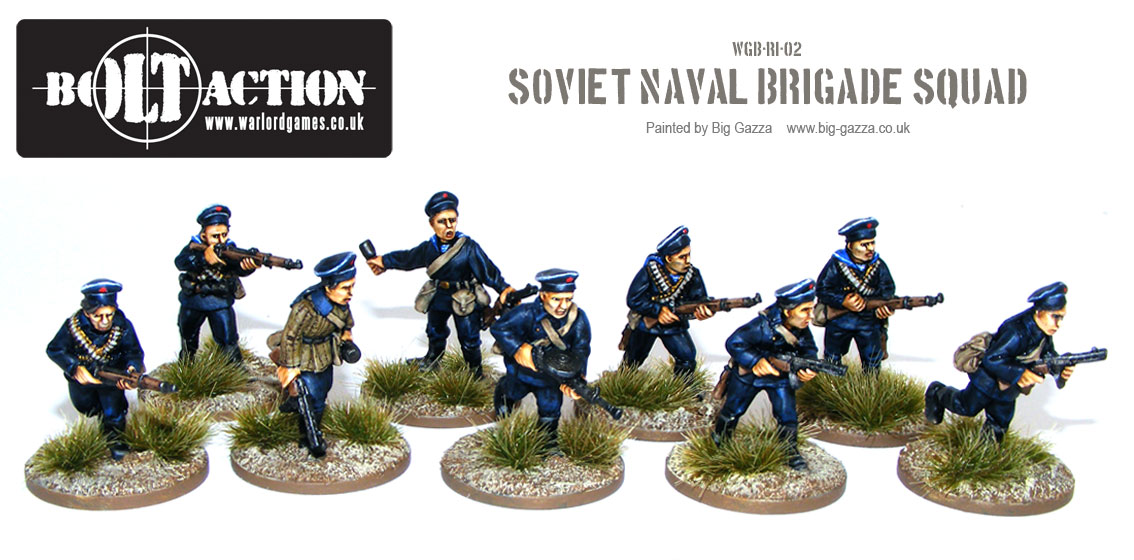 Simultaneously, the Ukrainian National Army, commanded by general Pavlo Shandruk, was created
Simultaneously, the Ukrainian National Army, commanded by general Pavlo Shandruk, was created The Galician Division nominally became the 1st Division of the Ukrainian National Army, although the German Army's High command continued to list it as the Ukrainian 14th SS Grenadier Division in its order of battle.
The Galician Division nominally became the 1st Division of the Ukrainian National Army, although the German Army's High command continued to list it as the Ukrainian 14th SS Grenadier Division in its order of battle.
The Division surrendered to British and US forces by 10 May 1945.
 Simultaneously, the Ukrainian National Army, commanded by general Pavlo Shandruk, was created
Simultaneously, the Ukrainian National Army, commanded by general Pavlo Shandruk, was created The Galician Division nominally became the 1st Division of the Ukrainian National Army, although the German Army's High command continued to list it as the Ukrainian 14th SS Grenadier Division in its order of battle.
The Galician Division nominally became the 1st Division of the Ukrainian National Army, although the German Army's High command continued to list it as the Ukrainian 14th SS Grenadier Division in its order of battle.
The Division surrendered to British and US forces by 10 May 1945.
The Ukrainian soldiers were interned in Rimini, Italy, in the area controlled by Polish II Corps forces. The UNA commander Pavlo Shandruk requested for a meeting with Polish general Władysław Anders in London, and asked him to protect the army against the deportation to Soviet Union. Despite the Soviet pressure, Anders managed to protect Ukrainian soldiers, as the former citizens of the Second Republic of Poland.
in London, and asked him to protect the army against the deportation to Soviet Union. Despite the Soviet pressure, Anders managed to protect Ukrainian soldiers, as the former citizens of the Second Republic of Poland.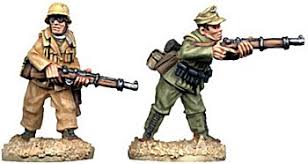
This, together with the intervention of the Vatican saved its members from deportation to the USSR. Bishop Buchko of the Ukrainian Greek Catholic Church had appealed to Pope Pius XII to intervene on behalf of the division, whom he described as "good Catholics and fervent anti-Communists".
Due to Vatican intervention, the British authorities changed the status of Division members from POW to surrendered enemy personnel and the Polish II Corps declined their deportation to Soviet Union. 176 soldiers of the division joined Władysław Anders's Polish army. This showe3d how quickly they could change flags .
 in London, and asked him to protect the army against the deportation to Soviet Union. Despite the Soviet pressure, Anders managed to protect Ukrainian soldiers, as the former citizens of the Second Republic of Poland.
in London, and asked him to protect the army against the deportation to Soviet Union. Despite the Soviet pressure, Anders managed to protect Ukrainian soldiers, as the former citizens of the Second Republic of Poland.This, together with the intervention of the Vatican saved its members from deportation to the USSR. Bishop Buchko of the Ukrainian Greek Catholic Church had appealed to Pope Pius XII to intervene on behalf of the division, whom he described as "good Catholics and fervent anti-Communists".
Due to Vatican intervention, the British authorities changed the status of Division members from POW to surrendered enemy personnel and the Polish II Corps declined their deportation to Soviet Union. 176 soldiers of the division joined Władysław Anders's Polish army. This showe3d how quickly they could change flags .
In 1947, former soldiers of SS "Galizien" were allowed to immigrate to Canada and to the United Kingdom.
The names of about 7,100 former soldiers of SS "Galizien" admitted to the UK have been stored in the so-called "Rimini List"
Despite several requests of various lobby groups, the details of the list have never been publicly released. Only in 2003 the anti-terrorist branch of Scotland Yard launched a massive investigation of the people from the list by cross-referencing NHS patient, social security and pension records. However the order to release confidential medical records was met with an outcry from civil liberties groups. Many Ukranoians were pursued for crtimes against humanity.
The names of about 7,100 former soldiers of SS "Galizien" admitted to the UK have been stored in the so-called "Rimini List"
Despite several requests of various lobby groups, the details of the list have never been publicly released. Only in 2003 the anti-terrorist branch of Scotland Yard launched a massive investigation of the people from the list by cross-referencing NHS patient, social security and pension records. However the order to release confidential medical records was met with an outcry from civil liberties groups. Many Ukranoians were pursued for crtimes against humanity.


